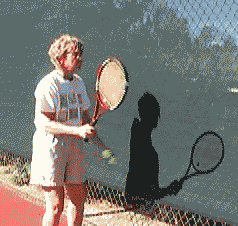|
TennisOne QuickTips
Volley like the Professionals A Firm Wrist will produce a Firm Forehand Volley Dave “Koz” Kozlowski
Scenario You have worked the point, rallying patiently from the baseline, waiting . . . waiting for the short ball and there it is. You approach confidently, slicing the ball into the backhand corner and move forward looking to volley into the open court. Your opponent answers with a floating backhand down the line. Here it comes. Racquet ready . . . then mysteriously you flop it into the net. Generally flop is not a word associated with the contact of racquet and ball, but in this case that is how it looked and that is how it felt. Nuts! So What is the Problem? Recreational players often volley without depth or power. What should be an easy sitter on the forehand side often winds up going into the net. If your forehand volley does not have any pop, it may have to do with the wrist position at contact. If the wrist is too active, the ball may be sprayed either too high and long or alarmingly, down and into the net. The Solution The solution is to lay the wrist back and keep it firm throughout the contact - that means BEFORE contact, DURING contact and AFTER contact.
Interestingly, a firm wrist is not necessarily a locked wrist, for when locked the player feels tension, and in fact may tense the arm to lock the wrist. On the contrary, if the wrist is laid back, the bones in the hand and wrist lock, that is they move to a point where they cannot move any further back, and now the wrist is locked without tension. This is a very important distinction! Players with a floppy or “active” wrist tend to lay the wrist back before contact, but unfortunately at some moment during contact they unlock the wrist and bring the tip of the racquet forward – and there again we have that darn volley falling aimlessly into the net. A Simple Practice Drill Go up against the fence at the back of the court and stand about a foot away from it. Toss the ball and try to trap it between your racquet and the fence. If you are doing it correctly you will trap the ball while your arm, wrist, and racquet forms the letter L. That is the feeling and position you want next time you close in on that forehand volley. |

